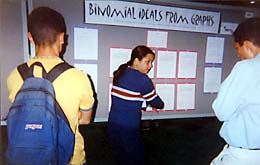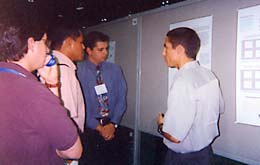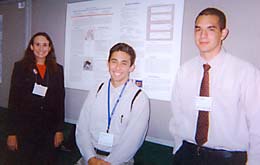
Mathematics at the Annual SACNAS Meeting, September 2001
The 2001 meeting of the Society for Advancement of Chicanos and Native Americans in Science (SACNAS) took place in Phoenix, Arizona, September 27-30. The AMS was among the conference sponsors and was one of approximately 160 societies, agencies, institutions and companies that provided information about educational programs, careers, internships and job opportunities in the sciences.
"SACNAS has re-dedicated its efforts to encourage Chicano/Latino and Native American undergraduates to pursue graduate degrees in science, mathematics and engineering. This goal permeates the entire conference. The first night of the conference begins with 'Conversations with Scientists', a SACNAS innovation. Undergraduates, graduate students, and professionals sit around large tables to talk about their careers, the process of applying for graduate school and how to fund these studies. At this latest conference, we had four mathematics tables filled to overflowing. Not only was it gratifying to see so many students at these tables, it is also noteworthy to see so many mathematicians there talking to the students. In particular, the American Mathematical Society sent two representatives to this meeting.
As a member of the AMS, I am pleased to see the AMS talking to these students. This presence will encourage our students to pursue graduate degrees and at the same time it will impress upon them a sense of professionalism. My hope is that the students at these tables will become members of the AMS in the not too distant future." --- William Yslas Velez, President of SACNAS (1994-96)


The Conference began with a number of K-12 Teacher Workshops, and many of those attendees stopped by the AMS booth, where they picked up our 'Guide to Online Resources for High School Students' flyer and a packet of the Mathematical Moments posters. Following the Welcome Reception, all gathered for a Native American Blessing, President Maria Elena Zavala's Welcome Address, and a dynamic keynote address by Eloy Rodriguez (Prof. of Biology and Environmental Science at Cornell University). The SACNAS Annual Meeting Program included addresses, scientific symposia, workshops, poster sessions, exhibits, and also breakfasts, lunches and dinners that offered the opportunity for students and other participants to mingle and hear other keynote speakers.
"As a longtime member of both SACNAS and the AMS, I have been delighted to see the way the two organizations have been working together in recent years toward getting more Latino, Chicano, and Native American students through the educational pipeline that leads to advanced degrees and research careers in mathematics. SACNAS has made an intensive effort to get more grad-school-bound mathematics undergraduates to its national conference, so that the number of such students at the conference has grown from a handful a few years ago to several dozen now. The AMS's active participation in the conference has helped make it a valuable activity for these students, and I know from my own conversations with the students that they are very appreciative of the friendly, personalized career information they receive from AMS personnel at these meetings, and of the interest that the AMS participants take in the students' own work on display at the poster presentations. We look forward to seeing these students back as professional mathematicians at both SACNAS and AMS meetings in years to come, and as leaders in both organizations. The support the AMS has shown for SACNAS's efforts is one of the factors that is going to make this possible." ---Robert Megginson, Prof. of Mathematics, University of Michigan at Ann Arbor




Undergraduate and graduate student poster presentations (listed below) were incorporated into the exhibit area. It was great to see and hear the mathematics students, nearly all of whom stopped by the AMS booth to request information on resources for undergraduates in mathematics, employment and career services, assistantships and graduate fellowships, Society activities and AMS membership. Several of the students had participated in REUs (Research Experiences for Undergraduates), and hoped to attend the Joint Mathematics Meetings in San Diego, January 6-9, 2002. It was also encouraging to see professional mathematicians at SACNAS, interacting with the students at poster presentations, meals, and social events, and sharing their experiences and encouraging the students in their pursuits.
"The SACNAS atmosphere has whetted the students' interest in attending the Joint Mathematics Meetings [January 6-9 in San Diego] so as to have an opportunity to interact with other students who share their interest in the mathematical sciences, to find out about mathematics programs, to discover "what's hot," to learn about options for graduate study and, to hear about career options. The extraordinary student and mentorship focus of the SACNAS meeting has created an interest in opportunities to have a different kind of experience, one that will engage them in experiences that will help them become even more successful in their educational programs and careers. My student participants saw and spoke about the mentoring of younger professors by senior professors, of graduate students and teachers by professors, of undergraduate students by everyone. It was the NSF VIGRE model of "vertical integration" in the flesh." --- Kenneth C. Millett, Prof. of Mathematics, Regional Director, California Alliance for Minority Participation Director, South Coast Community Teaching Fellowship in Mathematics and Science, University of California, Santa Barbara
"SACNAS has become the leading group in the promotion of graduate education in scientific disciplines among minority students. The presence of mathematics activities at the SACNAS annual conference has increased steadily in recent years due largely to the involvement of mathematician SACNAS members and to the support by organizations like the AMS." --- Ricardo Cortez, Asst. Prof. Mathematics Department, Tulane University, New Orleans
Carlos Castillo-Chavez, professor of biometrics at Cornell University, was awarded the prestigious Distinguished Scientist Award by SACNAS. He specializes in mathematical biology, social dynamics and mathematical and statistical approaches to AIDS epidemiology and other epidemic diseases. At Cornell, he is the director of the Mathematical and Theoretical Biology Institute (MTBI), which provides research opportunities for minority undergraduate students--several of whom presented posters at this SACNAS meeting. In 1997, he received the Presidential Award for Excellence in Science, Mathematics and Engineering Mentoring from President Bill Clinton. Castillo-Chavez also received a Presidential Faculty Fellowship Award in 1992 from then President George Bush, and in 2000 he received the Quality Education for Minorities Network's Giants in Science Award.
The Undergraduate and Graduate Poster Presentations in Mathematics (with the presenter's name listed first) were:
- Lexicographic and Non-Lexicographic Greedy Codes (Kishion Acosta, UCLA; Marian Hernández-Viera, Univ. of Puerto Rico-Humacao; José E. Lugo-Martínez, Univ. of Puerto Rico-Río Piedras)
- Integral Closure of Monomial ideals: The Square Case (Sotero Alvarado, Univ. of Calif., San Diego; Angela Esquibel, Univ. of New Mexico; Lianette Passapera-Sanchez, Univ. of Puerto Rico-Humacao)
- Integral Closure of Monomial Ideals: The Maximal Case (Carlos Arreola, UCLA; Ricardo Garza, Calif. State Univ., Bakersfield; Aida Yelitza Navarro-López, Univ. of Puerto Rico-Humacao)
- Disease Dynamics on Small-World and Other Networks (Gerardo Chowell, Fabio Sanchez, Cornell Univ.)
- The Tipping Point: Fact of Fantasy (Nicolas M. Crisosto, Stephen Wirkus, Christopher Kribs-Zaleta, MBTI at Cornell Univ.)
- Binomial Ideals from Graphs (Rodolfo de la Cruz, UC Santa Barbara; Elden Krause, Loyola Marymount Univ.; Patricia Pichardo, Georgia Institute of Technology)
- Diagonal Step Matrices (Arithmetic and Geometric Progression Case) (Rafael Del Valle-Vega, Univ. of Puerto Rico-Río Piedras; Kendall Atkinson, Philip Kutzko, Univ. of Iowa)
- Codes from N-Dimensional Polyhedra and N-Dimensional Cyclic Codes (Vanessa Díaz, Univ. of Puerto Rico-Rio Piedras; Carols Guevara, City College of New York; Michael Vath, Univ. of Notre Dame)
- Zero-Dimensional Gorenstein Ideals (Sarah Genoway, Univ. of Texas at Austin; Reyes M. Ortiz-Albino, Univ. of Puerto Rico-Mayagüez; Vanessa Tavares, Univ. of Calif., Berkeley
- Mouse in the House: Looking at the Spread of Hantavirus in Houses Through the Deer Mouse Population (Tiffany R. Hegg, Edgar Cabral, Brandon Brown, Cornell Univ.)
- The BIGR Model (Ryan D. Hernandez, Danielle Lyles, Daniel Rubin, Thomas Voden, Mathematical & Theoretical Biology Institute at Cornell Univ.)
- Different Strokes for Different Folks: The Evolution of the Distribution of Traits within Heterogeneous Populations (Paul J. Hurtado, Kara Cunningham, Heather Watson, Cornell Univ.)
- Generalized Hamming Weights for Linear Codes (Iskra Núñez, Univ. of Texas at El Paso; Estefan Ortiz, St. Mary's Univ.; Alicia Urdapilleta, Mills College)
- Buckling Compressive Failure of Single Fiber Composites (Sherlyne Paret, Carlos A. Torre, Jermaine Baldwin, Cornell Univ.)
- One-Palette N-Color Maximizable Graphs (Roberto C. Pelayo, Ramin Naimi, Occidental College)
- To BT or Not To BT? Balancing Spacial Genetic Heterogeniety to Control the Evolution of Ostrinia Nubilalis (Fernando L. Pena, Rosalyn Rael, Conrad Miller, Andres Munoz, Cornell Univ.
- Rave, Clubs and Ecstasy: The Impact of Peer Pressure (Karen R. Rios-Soto, Melissa Castillo-Garsow, Leilani Henson, Marcin Mejran, Univ. of Puerto Rico-Mayaqüez)
- Algebraic Geometry Codes and Elkies Codes (Bárbara Rivera, Univ. of Puerto Rico-Río Piedras; Eric Summerville, St. Mary's Univ.; Jessica Zúñiga, Rice Univ.
- Graphing Without Distortion (Guadalupe M. Rodriguez, Noemi Rodriguez, Venus Castellano, Univ. of Illinois at Chicago)
- A Variation of Lights Out, Modulo 3 (Christian J. Roldán-Santos, Jullian Martens, Lisa McGee, Lisa Sparrgrove, Summer Undergraduate Mathematical Sciences Research Institute, Miami Univ. Ohio)
- Delay Response in the Fitzhugh-Nagumo Equations: The Impact of Alcohol on Neuron Firing (Marco A. Sanchez, Ivy Prendergast, Shirley Sanchez, Romel Franca, Mathematical & Theoretical Biological Institute, Cornell Univ.)
- Am I Too Fat?: Bulimia as an Epidemic (Terannie Vazquez, Angela Ortiz-Nieves, Emilia Huerta-Sanchez, Beverly Gonzalez, Cornell Univ.)
- Effects of Education and/or Vaccination and/or Treatment on HIV Transmission in Homosexuals with Genetic Heterogeneity (Maria C. Velasco-Narvaez, Sara Del Valle, Arlene Evangelista, Cornell Univ.)
- Mathematical Foundations for Computer Simulations (Luis D. Garcia, Abdul Jarrah, Reinhard Laubenbacher)
- Dimensions of Interaction Flows: A Combinatorial Approach (Rebecca E. Pablo)
- A Model of Two Biological Oscillators (Erika T. Wirkus, Richard Rand, Howard Howland)
Visit the AMS Careers and Education web pages or email prof-serv@ams.orgfor more information on graduate studies in mathematics.
Thanks to Robert Megginson for photographs of the SACNAS meeting.

